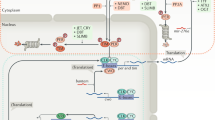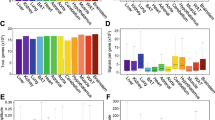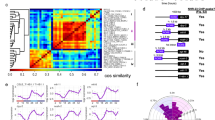Abstract
The timeless (tim) gene is essential for circadian clock function in Drosophila melanogaster1,2. A putative mouse homolog, mTimeless (mTim), has been difficult to place in the circadian clock of mammals. Here we show that mTim is essential for embryonic development, but does not have substantiated circadian function.
This is a preview of subscription content, access via your institution
Access options
Subscribe to this journal
Receive 12 print issues and online access
$209.00 per year
only $17.42 per issue
Buy this article
- Purchase on Springer Link
- Instant access to full article PDF
Prices may be subject to local taxes which are calculated during checkout



Similar content being viewed by others
References
Dunlap, J. C. Cell 96, 271–290 ( 1999).
Lee, C., Bae, K. & Edery, I. Mol. Cell. Biol. 19, 5316–5325 (1999).
Klein, D.C., Moore, R.Y. & Reppert. S.M. in Suprachiasmatic Nucleus: the Mind's Clock (New York, Oxford University Press, 1991).
Kume, K. et al. Cell 98,193–205 (1999).
Shearman L. P. et al. Science 288, 1013– 1019 (2000).
Koike, N. et al. FEBS Let. 441, 427–431 (1998).
Sangoram, A. M., et al. Neuron 21, 1101–1113 (1998).
Zylka, M. J. et al. Neuron 21, 1–20 (1998).
Takumi, T. et al. Genes Cells 4, 67–75 (1999).
Tischkau, S. A. et al. J. Neurosci. 19(RC15), 1 –6 (1999).
Field, M. D. et al. Neuron 25, 437–447 (2000).
Jin X. et al. Cell 96, 57–68 (1999).
Tothenfluh, A., Abodeely, M., Price, J. L. & Young, M. W. Genetics (in press).
Acknowledgements
We thank Lauren Shearman for assistance with in situ hybridization experiments. Supported by National Institutes of Health grants R37 HD14427 and RO1 NS39303. A.L.G. was supported by NRSA MH12117.
Author information
Authors and Affiliations
Corresponding author
Supplementary information
Rights and permissions
About this article
Cite this article
Gotter, A., Manganaro, T., Weaver, D. et al. A time-less function for mouse Timeless. Nat Neurosci 3, 755–756 (2000). https://doi.org/10.1038/77653
Received:
Accepted:
Issue Date:
DOI: https://doi.org/10.1038/77653
This article is cited by
-
Circadian oscillator proteins across the kingdoms of life: structural aspects
BMC Biology (2019)
-
Circadian clock genes are differentially modulated during the daily cycles and chronological age in the social honeybee (Apis mellifera)
Apidologie (2018)
-
Adaptive evolution of the circadian gene timeout in insects
Scientific Reports (2014)
-
Molecular genetics of the fruit-fly circadian clock
European Journal of Human Genetics (2006)



